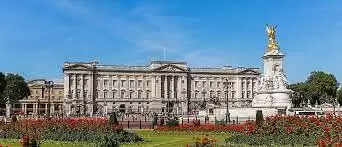These rare gifts from ancient Indian kingdoms were on display in Buckingham Palace on Friday

LONDON, June 9, 2018: Exquisite examples of Indian craftsmanship that took years to produce – including an illuminated 'Padshahnama' (Book of Emperors) and an 'attardan' (perfume holder) from Jaipur – are among more than 150 priceless items that went on display at the Buckingham Palace on Friday.
Highlighting India in London's cultural calendar during the summer, the Queen's Gallery in the palace is hosting two exhibitions titled "Splendours of the Subcontinent" – one on four centuries of South Asian paintings and manuscripts, and the other displaying gifts given to Albert Edward, Prince of Wales, who toured India during 1875-76.
Drawn from the royal collection, which contains one of the world's most wide-ranging compilations of material from the region, the items reflect the historic ritual of diplomatic gift-giving in the relationship between the British monarchy and rulers in South Asia.

Among the most important gifts is the 'Padshahnama' (Book of Emperors), the manuscript recording the reign of the Mughal emperor Shah Jahan, which was sent to George III by the ruler of Awadh in 1799. Ten paintings from the Padshahnama, the only contemporary illustrated imperial volume to survive, are on display.
Exhibition organisers said the Khamsa (Quintet) of Nava'i, 1492, and the Gulistan (Rose Garden) of Sa'di, 1584, also presented to George III, are among the finest examples of manuscripts that combine intricate calligraphy with exquisite illuminations.

Sacred religious texts too were presented as gifts, including the 3.5-metre Quran Scroll, thought to have been given to George IV by one of the rulers of the Carnatic. All 114 chapters of the Quran are written on the scroll's 5-cm surface in a miniscule naskh script, known as 'ghubar' (dust).
Queen Victoria acquired many South Asian books and manuscripts, including a volume of her own published journals, The Queen's Travels in Scotland and Ireland, translated into Hindi by the Maharaja of Benares. Here is a list of rare gifts from ancient Indian kingdoms that were displayed in Buckingham Palace on Friday
Less well known are the paintings and manuscripts given to, and bought by, King George V and Queen Mary during their two tours of South Asia in the early 20th century. They acquired contemporary works, such as Queen Tissarakshita, 1911, by Abanindranath Tagore, founder of the Bengal School of Art.
These include a series of 16 paintings from the Pahari region circa 1775–90, depicting the story of the boy Prahlada as told in the seventh book of the Bhagavata Purana, the sacredHindu text.
King George V's father, King Edward VII, went on a four-month tour in 1875–6 as the Prince of Wales. Travelling almost 10,000 miles and meeting more than 90 local rulers in an effort to establish personal and diplomatic links, he was presented with more than 2,000 examples of Indian design and craftsmanship as part of the traditional exchange of gifts.
Many gifts he received were ceremonial items connected to courtly customs, such as a pair of enamelled peacock feather fans, which play an important role in the spectacle of a durbar (audience).
A 10-piece gold service, given by the Maharaja of Mysore, contains an 'attardan' (perfume holder), rosewater sprinklers and a 'paandan' (betel-nut holder), items associated with welcoming guests to an Indian court.
Enamelled jewellery and decorative items from Jaipur were highly sought after by European visitors. An enamelled gold and diamond perfume holder, presented by Ram Singh II, Maharaja of Jaipur, took five years to produce. It opens like a lotus flower to reveal a hidden cup and cover, and is decorated with scenes of Jaipur's great palaces.
The exhibition will run from June 8 to October 14.
Source: Hindustan Times
Image Courtesy: Internet

















